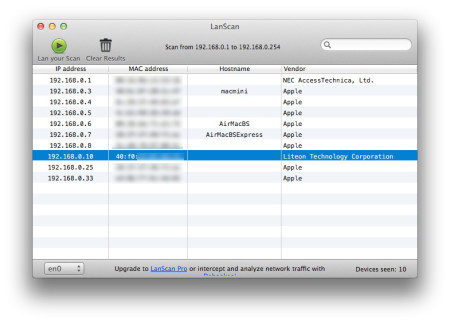

#Mac lanscan software
Note: Project demos are written using software design pattern MVVM How it works Feel free to copy/use them for your product. You can find project demos available in Swift or Objective-C.
#Mac lanscan install
To install using CocoaPods, simply add the following line to your Podfile:įunc lanScanDidFindNewDevice(_ device: MMDevice!)įunc lanScanDidFinishScanning(with status: MMLanScannerStatus)įunc lanScanProgressPinged(_ pingedHosts: Float, from overallHosts: Int)

Drag n Drop the MMLanScan folder in your project.Check in MainPresenter.m for more details
#Mac lanscan update
Gives you the ability to update the OUI (MAC-Brand mappings) plist file.Shows Brand of device based on MAC Address (iOS 10 and below).Scans and finds available hosts in your network.You can find a NativeScript wrapper of MMLanScan here! Screenshot We still using MacFinder since it's helpful in order to discover online devices that won't reply to pings. IOS 11 is breaking the MAC address retrieval from ARP table so MAC Addresses and Brands won't work on MMLanScan with iOS 11. This effort didn't seem to have any effect and the same problem exists in iOS 12.MMLanScan is an open source project for iOS that helps you scan your network and shows the available devices and their MAC Address, hostname and Brand name. Note 3: The Fing app guys who were facing the same issue created a petition here asking Apple to make MAC addresses accessible by network utility apps. Note 2: If you are wondering why your router's management app can show MAC addresses of connected devices, please check this FAQ.
#Mac lanscan android
Licenses cannot be shared between Android and iOS though so the Android version of the app has to be re-purchased from the Play Store. Note 1: Right now there is no such limitation on Android so if you have access to an Android phone, you can use the Android version of the app (or the free version). Maybe a a significant number of "me too"s might convince Apple to keep the ARP table accessible in some way. If the removal of the MAC-related features from the LAN scanner affects your business you might consider contacting Apple and explaining why it is important for you (you could reference the report number from the paragraph above so they can find more technical explanation of the problem). I created a new bug report in the Apple bug reporter (for reference, the number of the report is 32971866) suggesting this solution but it's up to Apple to decide whether to implement this or not. Apps which don't show MAC addresses directly to users wouldn't be allowed to get this permission. I believe there is a technical solution to this problem - there could be a new permission like "Network Utility" (either exposed to users or hidden from users and only checked during app review) which would allow network utility apps to access the potentially sensitive network-related information. This is a very unfortunate situation as it severely limits the functionality of the LAN scanner. checking the label on the back of the device or through the device's configuration menus - and then entered manually to the app.


 0 kommentar(er)
0 kommentar(er)
